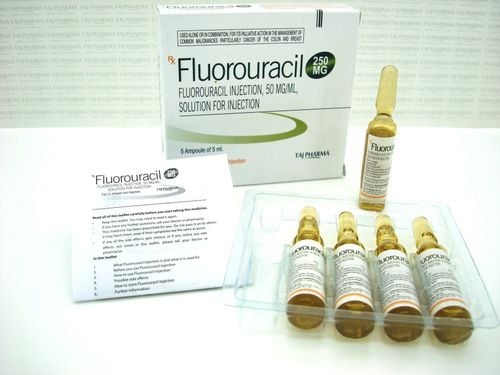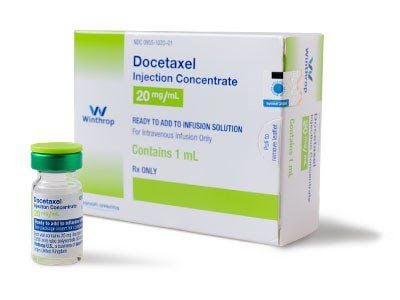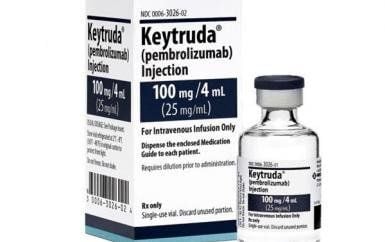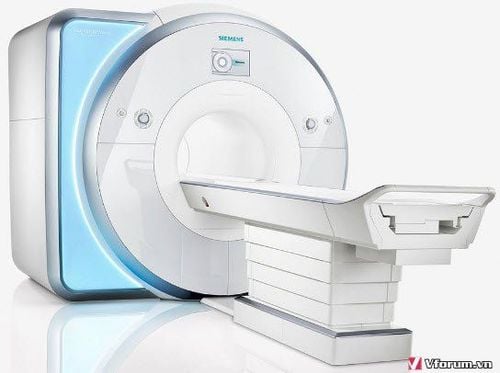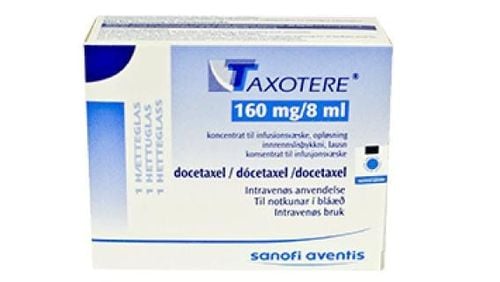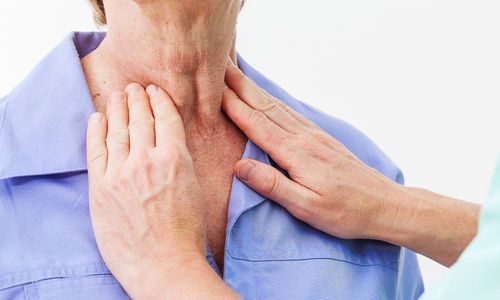This is an automatically translated article.
Posted by Master, Doctor Mai Vien Phuong - Department of Examination & Internal Medicine - Vinmec Central Park International General Hospital
Esophageal cancer (EC) is the 10th most common cancer and the 8th leading cause of death worldwide with more than 80% of deaths in developing countries. The epidemiology of esophageal cancer has undergone a significant change worldwide over the past 30 years. Esophageal cancers mainly fall into two distinct histological subtypes: squamous cell carcinoma (ESCC) and adenocarcinoma (EAC).
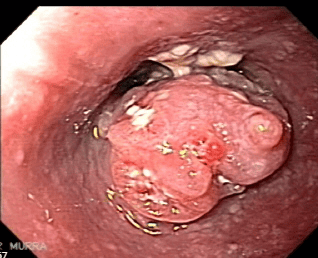
1. Global epidemiological trends
Huge differences in incidence exist between Asian and Western populations, and between countries, up to 500 times, and even within a particular country. The estimated worldwide incidence of esophageal cancer was 455,784 in 2012 with 400,156 deaths and is expected to be around 576,000 in 2015 with 486,000 deaths. The highest rates in both men and women were found in South and East Africa and East Asia with the lowest rates observed in West and Central America. West and Central Africa have very low rates, in sharp contrast to East and South Africa. An esophageal cancer belt (esophageal cancer belt) with the highest incidence of squamous cell carcinoma in the world - Exists in an area extending from the border of the Caspian Sea and Turkey through the southern republics of the former Soviet Union and into northern China.
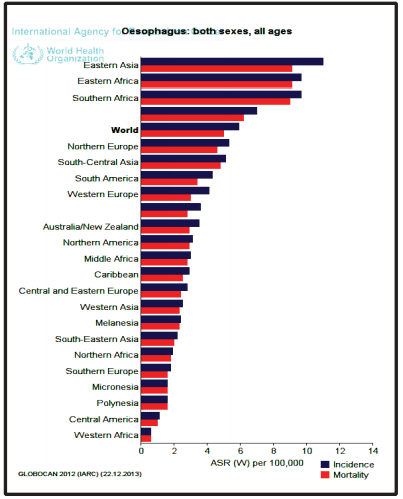
2. America
The United States ranks 67th in the incidence of esophageal cancer in the world, down significantly from 20th in 2002. It is estimated that there will be 18543 (men 14799 and women 3744) new cases. esophageal cancer in 2015 with 17469 deaths (men 14055 and women 3414). According to the National Cancer Institute's Surveillance, Epidemiology, and End Results (SEER) registry data, the incidence of adenocarcinoma has increased fivefold over the past 3 decades. The incidence of squamous cell carcinoma was highest three decades ago, at about 21 per 100,000, and has decreased by more than 60% since then to 7.6 per 100,000 in 2002. Esophageal cancer represents for 1.1% of all new cancer cases in the United States. Rates for new cases of esophageal cancer have decreased by an average of 0.9% per year over the past 10 years. The mortality rate decreased by an average of 0.6% per year over the same period. The number of new cases of esophageal cancer is 4.4 per 100,000 per year and the number of deaths is 4.3 per 100,000 per year.
Esophageal cancer incidence and mortality is increasing in white men, stable in white women, and decreasing in black men and women. White men have the highest incidence of adenocarcinoma while black men have a higher rate of squamous cell carcinoma, which has decreased in recent times. The incidence of adenocarcinoma, although low in African-Americans, has increased from 0.4/100,000 to 0.9/100,000 in men and 0-0.2/100,000 in women. There are large geographic variations in incidence and trends, especially for adenocarcinoma in men: age-standardized rates are highest in the Northeast (17.7 per 100,000) and the Midwest (18.1) with both significantly higher than the national estimate (16.0). Additionally, the Northeast Annual Percentage Change (APC) is 62% higher than the national estimate (3.19% vs. Finally, the incidence rate (IRR) remained fairly stable over calendar time, despite changes in incidence.
The overall incidence of esophageal cancer is higher in African-Americans than in whites (8.4 versus 8.0 cases per 100,000 people). Among African Americans, squamous cell carcinoma remains the predominant subtype with a six-fold higher rate of esophageal cancer than Caucasians. This rate is seen despite the fact that GERD is no less common in blacks than it is in whites in the United States. Ethnic survival rates also differ, with 5-year survival (%) between Caucasians and African-Americans with localized lesions 36% versus 20% and regional lesions. is 18% versus 11%.
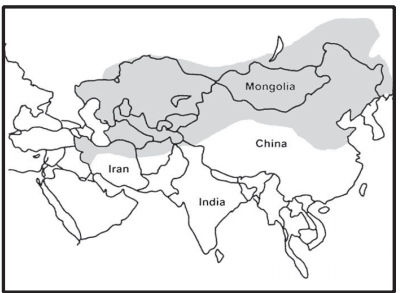
3. Europe
The UK has the highest age-standardized ratio (ASR) in Europe (6.5), followed by the Netherlands (6.3). The incidence of esophageal cancer in the UK, France, Portugal, Spain, Germany, Belgium, Italy, Denmark, the Netherlands and Greece between 1960-1964 and 1985-1989 and Finland has increased. and squamous cell carcinomas have had adenocarcinoma as the leading histological subtype. A recent study of (n = 43,753) examining the incidence of adenocarcinoma in England and Wales between 1971 and 2001 found a rapidly increasing age-standardized rate of 39.6% and 37.5% in men and women. This increase is seen at different socioeconomic levels; people in more affluent groups have a higher incidence of adenocarcinoma than others. The incidence of esophageal cancer in South Asians and blacks is lower than in whites, about two-thirds and one-third, respectively. In Sweden, esophageal and gastric cancers have not increased since 2005, compared with increases between 1970-2000. In the UK, 'non-white' groups have lower rates of esophageal, colorectal and pancreatic cancers than Caucasians and higher rates of liver and gallbladder cancers. There is a difference in risk among Indians, Pakistanis and Bangladeshis for cancers of the esophagus, stomach, liver, and gallbladder. Caucasians have the highest incidence of esophageal cancer (5.8), followed by Indians and Bangladeshis. Interestingly, the Chinese in the UK have a low ratio compared to whites and Indians. The lower incidence in all ethnic groups compared with Caucasians is largely due to the lower incidence of adenocarcinomas than for squamous cell carcinomas. Esophageal cancer rates are lower in South Asians than in both their country of origin and in whites in the UK.

Currently, Vinmec International General Hospital has deployed the package for screening and early detection of gastrointestinal cancers (esophagus - stomach - colon) esophagus - stomach - colon) of Vinmec combines clinical and paraclinical examination to bring about the most accurate results possible. Specifically, Vinmec's package of screening and early detection of gastrointestinal cancer (esophagus - stomach - colon) includes:
Gastroenterology specialist examination (by appointment) Gastroscopy and colonoscopy with NBI endoscope with anesthesia Gastroscopy and colonoscopy with anesthesia (Drugs) Gastroscopy and colonoscopy with anesthesia (VTTH) Routine histopathological examination fixed, transferred, cast , cut, stain... biopsies (upper gastrointestinal tract (esophagus, stomach, duodenum, papilla) through endoscopy Routine histopathological examination is fixed, transferred, cast, cut, and stained. ..biopsy specimens (lower gastrointestinal tract through endoscopy (colon, rectum)
Please dial HOTLINE for more information or register for an appointment HERE. Download MyVinmec app to make appointments faster and to manage your bookings easily.
ReferencesJaneesh sekkath veedu , changing epidemiology of esophageal cancers worldwide – what do we learn? Epidemiology of gastrointestinal cancers,
2, practicalgastro, january 2014 • volume XXXVIII, issue 1. Parkin DM, Bray F, Ferlay J, Pisani P. Global cancer statistics, 2002. CA Cancer J Clin. Mar-Apr 2005;55(2):74-108. Stavrou EP, McElroy HJ, Baker DF, Smith G, Bishop JF. Adenocarcinoma of the oesophagus: incidence and survival rates in New South Wales, 1972-2005. Med J Aust. Sep 21 2009;191(6):310-314.





